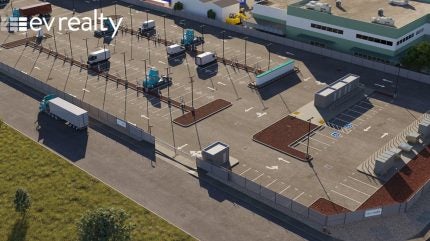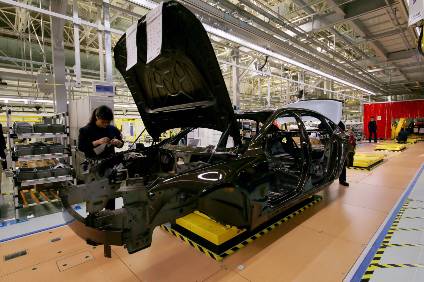
Although making up a small percentage of vehicles on the road, sitting at 5%, medium and heavy-duty trucks are responsible for 25% of transport greenhouse gas emissions in the US. With emissions and decarbonisation at the forefront of the automotive industry’s mind – what can be done to reduce the sector’s carbon impact.
On a mission of assist the industry look for ways to decarbonise, EV Realty, a company who develops, deploys, and owns grid-scale charging infrastructure, is focusing in on medium and heavy-duty trucking and helping build out infrastructure while developing a platform that it says can power commercial fleets.
We spoke to EV Realty CEO, Patrick Sullivan, to discuss the Hub Based Strategy vs the Transportation Corridor strategy as well as future predictions for the heavy-duty EV space.

Just Auto (JA): Could you provide me with some background on the company?
Patrick Sullivan (PS): EV Realty develops, deploys, and owns charging infrastructure critical to electrifying commercial fleets in the US at scale. We are accelerating the adoption of large EV fleets by focusing on the fundamental constraint all electric fleets face: low-cost, reliable, and expandable access to grid-scale power. EV Realty is developing a network of grid-optimised, large-scale EV charging hubs for delivery, logistics, and services fleet customers.
Our Powered Properties serve multiple commercial fleets in secure, high-power locations with guaranteed charging access and availability, and are located proximate to major logistics corridors within last-mile delivery/duty range of urban population centres. By aggregating multiple fleets with shared private infrastructure in grid-ready locations, our charging hubs reduce upfront and recurring costs for fleets while optimizing the investment in infrastructure.
How well do you really know your competitors?
Access the most comprehensive Company Profiles on the market, powered by GlobalData. Save hours of research. Gain competitive edge.

Thank you!
Your download email will arrive shortly
Not ready to buy yet? Download a free sample
We are confident about the unique quality of our Company Profiles. However, we want you to make the most beneficial decision for your business, so we offer a free sample that you can download by submitting the below form
By GlobalDataEV Realty’s chief business officer was recently at the White House discussing the Zero-Emission Freight Infrastructure. The company has raised a total of $28m and recently announced a $200m joint venture with GreenPoint Partners that will accelerate our ability to procure and develop more charging hubs.
We currently have three publicly announced projects in California; firstly, a public access fast charging project in Oakland with 17 dual-port fast chargers in partnership with Ava Community Energy, the electricity provider to more than 1.7 million residential and commercial customers in Alameda County. There’s also a charging hub for commercial fleets in Livermore located between the Port of Oakland and Port of Stockton, and a commercial fleet charging hub in San Bernardino near the airport and the I-215 / I-10 interchange.
What is the Hub Based Strategy vs the Transportation Corridor strategy?
The Hub Based Strategy is focused on serving a targeted geographic area that contains fleets that drive daily routes and return to their depot each night – commonly known as “return-to-base fleets.” We can use our proprietary software to identify property inside that geography with large amounts of available power, to provide a charging hub – called a Powered Property – for the use of numerous local fleets. This coincides with Phase 1 of the Biden Administration’s National Zero-Emission Freight Corridor Strategy.
The Corridor Strategy centres around placing charging stations on heavily trafficked roadways between two primary freight destinations, typically on longer routes that do not return to their destination on the same day. We place an emphasis on a hub-based approach and finding large industrial sites with built-in energy infrastructure and can offer a mix of fleets to charge at our facilities.
How does the ‘Grid first’ acquisition give the company more cost responsible solutions?
The grid first approach is beneficial to all parties involved and is truly a win-win. By identifying property with existing power available we are reducing the backlog of upgrade requests on the local utility companies, which in turn also reduces the cost burden on the local rate base keeping utility rates lower. Additionally, this approach helps EV Realty to avoid upgrade delays for our site, and results in our infrastructure being on-line sooner, allowing the goals of ACF (Advanced Clean Fleets – a California initiative) to be reached sooner by accelerating the reduction of CO2 around our facilities.
The grid first approach is beneficial to all parties involved and is truly a win-win
Lastly, and important to our customer base, avoiding the cost of upgrades means we can bring charging stations online at a more economical price for our customer base.
What can we expect to see in the EV space when it comes to medium and heavy-duty vehicles?
Despite making up just 5% of vehicles on the road, medium and heavy-duty trucks produce almost 25% of all transportation emissions in the US, so we can expect to see more solutions and efforts to decarbonize the space by transitioning to EVs and building out more charging locations. Medium and heavy-duty vehicles operate on different schedules and use cases than consumer vehicles, so figuring out the most effective way to enable EV fleets to effectively fuel without overloading the grid are the solutions that need our attention.
What are the goals for this year?
In the short-term, our goals remain to break ground on our existing properties in Livermore and San Bernardino and continue to acquire more properties throughout California in support of our hub-based strategy. Longer term, we will expand beyond California, to support fleet customers with charging solutions in other key locations across the country.
In addition to our own projects, we are continuing to provide support to policy that can push the industry forward and allow more opportunity to decarbonize the entire medium and heavy-duty trucking industry. These policies include California’s recent enactment of the Advanced Clean Fleets initiative, as well as the Biden-Harris administration laying out their heavy-duty truck emissions regulations and the national freight charging infrastructure strategy.







